2010 eruptions of Eyjafjallajökull
| 2010 eruptions of Eyjafjallajökull | |
|---|---|
|
Volcano plume on 18 April 2010 | |
| Volcano | Eyjafjallajökull |
| Date | 20 March – 23 June 2010 |
| Type | Strombolian and Vulcanian eruption phases |
| Location |
Iceland 63°37′59″N 19°36′00″W / 63.633°N 19.6°WCoordinates: 63°37′59″N 19°36′00″W / 63.633°N 19.6°W |
| VEI | 4 |
| Impact | large-scale disruption to air travel, smaller effects on farming in Iceland |
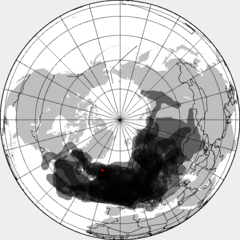 Composite map of the volcanic ash cloud spanning 14–25 April 2010 | |
The 2010 eruptions of Eyjafjallajökull were volcanic events at Eyjafjallajökull in Iceland which, although relatively small for volcanic eruptions, caused enormous disruption to air travel across western and northern Europe over an initial period of six days in April 2010. Additional localised disruption continued into May 2010. The eruption was declared officially over in October 2010, when snow on the glacier did not melt. From 14–20 April, ash covered large areas of northern Europe when the volcano erupted. About 20 countries closed their airspace to commercial jet traffic and it affected about 10 million travellers.[1]
Seismic activity started at the end of 2009 and gradually increased in intensity until on 20 March 2010, a small eruption started rated as a 1 on the volcanic explosivity index.[2]
Beginning on 14 April 2010, the eruption entered a second phase and created an ash cloud that led to the closure of most of the European IFR airspace from 15 until 20 April 2010. Consequently, a very high proportion of flights within, to, and from Europe were cancelled, creating the highest level of air travel disruption since the Second World War. The second phase resulted in an estimated 250 million cubic metres (330,000,000 cu yd) (0.25 km3) of ejected tephra and an ash plume that rose to a height of approximately 9 kilometres (30,000 ft), which rates the explosive power of the eruption as a 4 on the volcanic explosivity index.[3] By 21 May 2010, the second eruption phase had subsided to the point that no further lava or ash was being produced.
By the evening of 6 June 2010, a small new crater had opened up on the west side of the main crater. Explosive activity from this new crater was observed with emission of small quantities of ash.[4] Seismic data showed that the frequency and intensity of earth tremors still exceeded the levels observed before the eruption, therefore scientists at the Icelandic Meteorological Office[5] (IMO) and the Institute of Earth Sciences, University of Iceland[6] (IES) continued to monitor the volcano.
In October 2010, Ármann Höskuldsson, a scientist at the University of Iceland Institute of Earth Sciences, stated that the eruption was officially over, although the area was still geothermally active and might erupt again.[7]
Background
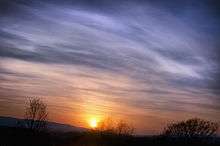
Eyjafjallajökull (pronounced [ˈɛɪjaˌfjatl̥aˌjœkʏtl̥]) is one of Iceland's smaller ice caps located in the far south of the island. It's situated to the north of Skógar and to the west of the larger ice cap Mýrdalsjökull. The ice cap covers the caldera of a volcano 1,666 metres (5,466 ft) high, which has erupted relatively frequently since the last ice age. The most recent major eruptions occurred in 920, 1612 and from 1821 to 1823.[8] Previous eruptions of Eyjafjallajökull have been followed by eruptions at its larger neighbour, Katla.[9] On 20 April 2010 Icelandic President Ólafur Grímsson said that, "the time for Katla to erupt is coming close ... we [Iceland] have prepared ... it is high time for European governments and airline authorities all over the world to start planning for the eventual Katla eruption".[10]
The volcanic events starting in March 2010 were considered to be a single eruption divided into phases. The first eruption phase ejected olivine basaltic andesite lava[11] several hundred metres into the air in what is known as an effusive eruption. Ash ejection from this phase of the eruption was small, rising to no more than 4 kilometres (2.5 mi) into the atmosphere.
On 14 April 2010, however, the eruption entered an explosive phase and ejected fine glass-rich ash to over 8 kilometres (5.0 mi) into the atmosphere. The second phase was estimated to be a VEI 4 eruption, which was large, but not nearly the most powerful eruption possible by volcanic standards. By way of comparison, the Mount St. Helens eruption of 1980 was rated as 5 on the VEI, and the 1991 eruption of Mount Pinatubo was rated as a 6. This second phase erupted trachyandesite.[12]
What made this volcanic activity so disruptive to air travel was the combination of these factors:
- The volcano was directly under the jet stream.
- The direction of the jet stream was unusually stable at the time of the eruption's second phase, continuously southeast.
- The second eruptive phase happened under 200 m (660 ft) of glacial ice. The resulting meltwater flowed back into the erupting volcano, which created two specific phenomena:
- The rapidly vaporising water significantly increased the eruption's explosive power.
- The erupting lava cooled very fast, which created a cloud of highly abrasive glass-rich ash.
- The volcano's explosive power was enough to inject ash directly into the jet stream.
Without this combination of factors, the eruption of Eyjafjallajökull would have been a medium-sized, somewhat nondescript eruption of little interest to those outside the scientific community or those living nearby. However, the above factors were precisely those needed for the jet stream to carry the ash directly over northern Europe into some of the busiest airspace in the world.
Public observations
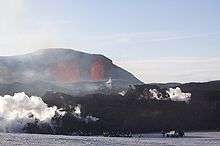
"Volcano tourism" quickly sprang up in the wake of the eruption, with local tour companies offering day trips to see the volcano.[13] The Civil Protection Department[14] of the Icelandic Police produced regular reports about access to the area, including a map of the restricted area around Eyjafjallajokull, from which the public was excluded. Teams from the Icelandic Association for Search and Rescue were stationed at the eruption site as part of standard safety measures and to assist in enforcing access restrictions.
Vodafone and the Icelandic telecommunications company Míla installed webcams, giving views of the eruption from Valahnúkur, Hvolsvöllur, and Þórólfsfell. The view of the eruption from Þórólfsfel also includes a thermal imaging camera.
Scientific observations
This eruption was assigned the volcano number 1702-02[15] by the Global Volcanism Program.
The London Volcanic Ash Advisory Centre[16] (VAAC), part of the UK Met Office, was responsible for forecasting the presence of volcanic ash in the north-east Atlantic. All ash dispersion models for this geographic region were produced by the VAAC in London.
A study by the Icelandic Meteorological Office published on December 2009 indicated an increase in seismic activity around the Eyjafjallajökull area during the years 2006–2009. The study reported increased activity that occurred between June and August 2009 (200 events), compared to a total of about 250 earthquakes recorded between September 2006 and August 2009. It further indicated that the locations of most of the earthquakes in 2009 occurred between 8 to 12 kilometres (5.0 to 7.5 mi) depth east of the volcano‘s top crater.[17] At the end of December 2009, seismic activity began around the Eyjafjallajökull volcano area, with thousands of small earthquakes (mostly of magnitude 1–2 Mw), 7 to 10 kilometres (4.3 to 6.2 mi) beneath the volcano.[18]
The radar stations of the Meteorological Institute of Iceland did not detect any appreciable amount of volcanic ashfall during the first 24 hours of the eruption.[19] However, during the night of 22 March, they reported some volcanic ash fall reaching the Fljótshlíð area (20 to 25 kilometres (12 to 16 mi) north-west of the eruption's location)[20] and Hvolsvöllur town (40 kilometres (25 mi) north-west of the eruption location)[20] leaving vehicles with a fine grey layer of volcanic ash. At around 07:00 on 22 March, an explosion launched eruption columns as far as 4 kilometres (13,000 ft) straight up into the air. This was the highest plume since the eruption started.[21] On 23 March, a small vapour explosion took place, when hot magma came into contact with nearby snowdrifts, emitting a huge vapour plume which reached an altitude of 7 kilometres (23,000 ft), and was detected on radars from the Meteorological Institute of Iceland. Since then many vapour explosions have taken place.[22]
By 26 February 2010 the Global Positioning System (GPS) equipment used by the Iceland Meteorological Office[23] at Þorvaldseyri farm in the Eyjafjöll area (around 15 kilometres (9.3 mi) southeast of the location of the recent eruption)[20] had shown 3 centimetres of displacement of the local crust in a southward direction, of which a 1 centimetre displacement had taken place within four days. (See the GPS Time Series[24] page of the Nordic Volcanological Center's[25] website for detailed information on the degree of movement detected in the Earth's crust in the Eyjafjallajökull locality.)
This unusual seismic activity along with the rapid movement of the Earth's crust in the area gave geophysicists evidence that magma was flowing from underneath the crust into Eyjafjallajökull's magma chamber and that pressure stemming from the process caused (in geophysical terms) the huge crustal displacement at Þorvaldseyri farm.[26] The seismic activity continued to increase and from 3 to 5 March, close to 3,000 earthquakes were measured having their epicentre at the volcano. Most of these were too small (magnitude 2) to be interpreted as precursors to an eruption, but some could be detected in nearby towns.[27]
The grounding of European flights avoided about 3.44×108 kg of CO2 emissions per day, while the volcano emitted about 1.5×108 kg of CO2 per day.[28]
Phase 1: Effusive eruption
The first phase of the eruption lasted from 20 March to 12 April 2010 and was characterised by olivine basaltic andesite lava flowing from various eruptive vents on the flanks of the mountain.
Evacuations
About 500 farmers and their families from the areas of Fljótshlíð, Eyjafjöll, and Landeyjar were evacuated overnight (including a group of 30 schoolchildren and their three teachers[29][30] from Caistor Grammar School in England), and flights to and from Reykjavík and Keflavík International Airport were postponed, but on the evening of 21 March, domestic and international air traffic was allowed again.[31][32][33] Inhabitants of the risk zone of Fljótshlíð, Eyjafjöll, and Landeyjar area were allowed to return to their farms and homes after an evening meeting with the Civil Protection Department on 22 March and the evacuation plan was temporarily dismissed. Instead, the police closed the road to Þórsmörk and the four-wheel-drive trail from Skógar village to the Fimmvörðuháls mountain pass, but these roads and trails were reopened on 29 March, though only for suitable four-wheel drives. When the second fissure appeared, the road was closed again because of the danger of flash floods, which could have developed if the fissure had opened near big ice caps or other snow reservoirs, but the road was again opened at around noon on 1 April.[34][35][36]
Effects on the river
On 22 March, a flow meter device in the Krossá glacial river (which drains Eyjafjallajökull and Mýrdalsjökull glaciers) in the Þórsmörk area (a few kilometres north-west of the erupting location) started to record a sudden rise in water level and in water temperature – the total water temperature rose by 6 °C (11 °F) over a two-hour period, which had never happened so quickly in the Krossá river since measurements began. Shortly afterward, the water level returned to normal and water temperature decreased.[37] It was thought that this rise in water temperature was related to the eruption nearby and was affecting part of the Krossá drainage basin. The temperature of Hruná river, which flows through the narrow Hrunárgil canyon, into which part of the lava stream was flowing, was recently recorded by geologists to be between 50 °C (122 °F) and 60 °C (140 °F), indicating that the river was cooling the lava in that canyon.[38]
Fissure
The first phase of the 2010 eruption began late on the evening of 20 March at the Eyjafjallajökull.
The initial visual report of the eruption was at 23:52 GMT, when a red cloud was seen at the north slopes of Fimmvörðuháls mountain pass,[39][40] lighting up the sky above the eruptive site. The eruption was preceded by intense seismicity and high rates of deformation in the weeks before the eruption, in association with magma recharging of the volcano. Immediately before the eruption, the depth of the seismicity had become shallow but was not significantly enhanced from what it had been in the previous weeks. Deformation was occurring at rates of up to a centimetre a day since 4 March at various GPS sites installed within 12 kilometres (7.5 mi) from the eruptive site.
A fissure opened up about 150 metres (490 ft) in length running in a north-east to south-west direction, with 10 to 12 erupting lava craters ejecting lava at a temperature of about 1,000 °C (1,800 °F) up to 150 metres (490 ft) into the air. The lava was alkali olivine basalt[41] and was relatively viscous causing the motion of the lava stream to the west and east of the fissure to be slow. The molten lava flowed more than 4,000 metres (2.5 mi) to the north-east of the fissure and into Hrunagil canyon, forming a lava fall more than 200 metres (660 ft) long and slowly approaching Þórsmörk, but had not yet reached the flood plains of Krossá.[42][43][44]
On 25 March 2010, while studying the eruption, scientists witnessed, for the first time in history, the formation of a pseudocrater during a steam explosion.[45] Crustal expansion continued at Þorvaldseyri for two days after the eruption began, but was slowly decreasing whilst the volcanic activity was increasing. This indicates that the rate at which magma was flowing into the magma chamber roughly equaled the rate at which it was being lost due to the eruption, giving evidence that this phase of volcanic activity reached equilibrium.[46]
A new fissure opened on 31 March, around 200 metres (660 ft) north-west of the original fissure.[47] Many witnesses were present while the new fissure opened. It was a bit smaller, around 300 metres (980 ft) long according to witnesses, and lava coming from it started to flow into Hvannárgil canyon. These two erupting fissures shared the same magma chamber, according to geophysicists. No unusual seismic activity was detected at the time the new fissure appeared, nor any crustal expansion according to many seismometers and GPS recorders situated in nearby areas.[48][49]
Geophysicist Magnús Tumi Einarsson said (at a press meeting in Hvolsvöllur on 21 March) that this eruption was small compared to, for example, the eruption of Hekla in 2000. The eruption, rather than taking place under the ice cap of the glacier, occurred in the mountain pass between the Eyjafjallajökull and Mýrdalsjökull glaciers. As long as the fissure was not near the glacier, the risk of flooding was minimal; however, the fissure could extend into the ice cap thereby greatly increasing the risk of flooding.[50]
Phase 2: Explosive eruption
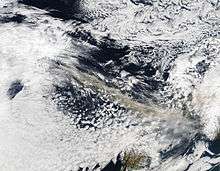
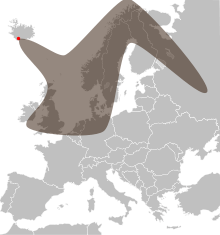
After a short hiatus in eruptive activity a new set of craters opened early in the morning of 14 April 2010 under the volcano's ice covered central summit caldera. Prior to this event, a large increase in seismic activity was detected between 23:00 on 13 April and 1:00 on 14 April. The earthquake swarm was followed by the onset of a seismic eruption tremor. Meltwater started to emanate from the ice cap around 07:00 on 14 April and an eruption plume was observed in the early morning. Visual observations were greatly restricted due to cloud cover over the volcano, but an aeroplane of the Icelandic Coast Guard imaged eruptive craters with radar instruments. A series of vents along a 2-kilometre (1.2 mi) long north-south oriented fissure were active, with meltwater flowing mostly down the northern slopes of the volcano, but also to the south. An ash loaded eruption plume rose to more than 8 kilometres (5.0 mi), deflected to the east by westerly winds.
Ash analysis
Samples of volcanic ash collected near the eruption showed a silica concentration of 58%—much higher than in the lava flows.[51] The concentration of water-soluble fluoride was one third of the concentration typical in Hekla eruptions, with a mean value of 104 milligrams of fluoride per kilogram of ash. Agriculture is important in this region of Iceland,[52] and farmers near the volcano have been warned not to let their livestock drink from contaminated streams and water sources,[53] as high concentrations of fluoride can have deadly renal and hepatic effects, particularly in sheep.[54]
Impact on farming
The Icelandic Food and Veterinary Authority released an announcement on 18 April 2010, asking that all horse owners who keep their herds outside be on the alert for ash fall. Where there was significant ash fall, all horses had to be sheltered indoors.[55] The thick layer of ash that had fallen on some Icelandic farms and pastures at Raufarfell had become wet and compact, making it very difficult to continue farming, harvesting or grazing livestock.[56]
Timeline of the second eruption phase
Unlike the earlier eruption phase, the second phase occurred beneath glacial ice. Cold water from melted ice quickly chilled the lava causing it to fragment into highly abrasive glass particles that were then carried into the eruption plume. This, together with the magnitude of the eruption (estimated to be VEI 4)[3] and being ten to twenty times larger than the eruption of Fimmvörðuháls on 20 March, injected a glass-rich ash plume into the jet stream.
In addition to volcanic ash being very hazardous to aircraft,[57] the location of this eruption directly under the jet stream ensured that the ash was carried into the heavily used airspace over northern and central Europe.
Phase 3: Return to dormancy
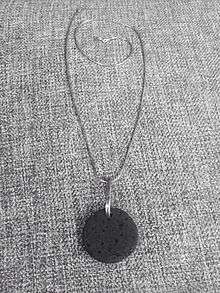
By the morning of 24 May 2010, the view from the web camera installed on Þórólfsfell[58] showed only a plume of water vapour surrounded by a bluish haze caused by emission of sulphurous gases. Due to the large quantities of dry volcanic ash lying on the ground, surface winds frequently lifted up an "ash mist" that significantly reduced visibility and made web camera observation of the volcano impossible.[59]
On 21 June 2010, data from seismic recorders in the area indicated that the frequency and strength of earth tremors had diminished, but were continuing.[60]
On 23 June 2010, the activity of Eyjafjallajökull had reduced to occasional, brief bursts of ash that traveled no more than a few tens of metres.
In October 2010, Ármann Höskuldsson, a scientist at the University of Iceland Institute of Earth Sciences, stated that the eruption was officially over, although the area was still geothermally active and might erupt again.[7]
Volume of erupted material and magma discharge
The Institute of Earth Sciences[61] made a preliminary estimate of erupted material in the first three days of the eruption on 14 April 2010 at Eyjafjallajökull. The erupted products were fragmented material, the majority fine-grained airborne tephra. Eruptive products can be split into three categories along with preliminary estimated erupted volumes:
- Material (tephra) in the ice cauldrons around the volcanic vents: 30 million cubic metres (39,000,000 cu yd)
- Tephra filling the glacial lagoon of Gígjökulslón, carried by floods down the outlet glacier Gígjökull: 10 million cubic metres (13,000,000 cu yd)
- Airborne tephra that was carried to the east and south of the volcano. Uncompacted tephra fallout from eruption plume: 100 million cubic metres (130,000,000 cu yd)
Total: 140 million cubic metres (180,000,000 cu yd) which corresponds to some 70–80 million cubic metres (92,000,000–105,000,000 cu yd) of magma. The magma discharge rate was about 300 cubic metres per second (11,000 cu ft/s) or 750 t/s. This was 10–20 times the average discharge rate in the preceding flank eruption at Fimmvörðuháls. (First Eruption on 20 March 2010).[62]
The IES updated the eruption flow rate on 21 April 2010 to estimation of less than 30 cubic metres per second (1,100 cu ft/s) of magma, or 75 tonnes/s, with a large uncertainty. IES also noted that the eruption continue with less explosive activity.[63]
Health effects
There were no human fatalities from the 2010 eruption of Eyjafjallajökull. The population who lived near the volcano had high levels of irritation symptoms, though their lung function was not lower than expected.[64] Six months later, the population living in the area had more respiratory symptoms than a control group from North Iceland, where there was no ashfall.[65] In Scotland, the number of phone calls to health services for respiratory and eye irritation did not rise significantly.[66]
Effects of the ash plume on air travel
Volcanic ash is a major hazard to aircraft.[67] Smoke and ash from eruptions reduce visibility for visual navigation, and microscopic debris in the ash can sandblast windscreens and melt in the heat of aircraft turbine engines, damaging engines and making them shut down.[57][67] Many flights within, to, and from Europe were cancelled following the 14 April 2010 eruption, and although no commercial aircraft were damaged, the engines of some military aircraft were harmed.[68][69] The presence and location of the plume depends upon the state of the eruption and the winds. While some ash fell on uninhabited areas in Iceland, most had been carried by westerly winds resulting in the shut down of a large air space over Europe. The shut down had a knock on impact on the economy and cultural events across Europe. The Icelandic flag carrier airline, Icelandair, seemed at first especially vulnerable, but managed to deal effectively with the eruption and subsequently published a detailed report about its actions and conclusions.[70]
Short- and long-term weather and environmental effects
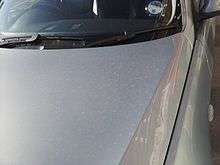
At the mouth of the crater, the gases, ejecta, and volcanic plume have created a rare weather phenomenon known as volcanic lightning (or a "dirty thunderstorm").[71] When rocks and other ejecta collide with one another, they create static electricity. This, with the abundant water-ice at the summit, aids in making lightning.[72]
High-fluoride Hekla eruptions pose a threat to foraging livestock, especially sheep. Fluoride poisoning can start in sheep at a diet with fluorine content of 25 ppm. At 250 ppm, death can occur within a few days.[54] In 1783, 79 percent of the Icelandic sheep stock were killed, probably as a result of fluorosis caused by the eruption of Laki.[73] The effect also spread beyond Iceland.[74] Ash from the current Eyjafjallajökull eruption contains one third the concentration typical in Hekla eruptions, with a mean value of 104 milligrams of fluoride per kilogram of ash. Large-scale release of sulphur dioxide into the troposphere also poses a potential health risk, especially to people with pre-existing breathing disorders.
While it is suspected that major volcanic eruptions that coincide with cyclic solar minimum activity[75][76] could produce temporary global cooling or reduction in global temperature,[77][78] it is noted[79] that coincidentally the earth-facing side of the Sun was mostly blank with no sun spots since the start of the second eruption phase on 14 until 29 April 2010.[80] Although the current unusually long solar minimum came to a close earlier this year, the current cycle may witness unusual weak solar maximum. Other research links volcanic eruptions including recent Icelandic activity to the solar cycle. Most consider the climate anomaly of the Year Without A Summer 1816 to have been caused by a combination of a historic low in solar activity with a volcanic winter event; the latter caused by a succession of major volcanic eruptions capped off by the Mount Tambora eruption of 1815, the largest known eruption in over 1,600 years.[81][82][83][84][85][86] One proposed volcanic winter happened c. 70,000 years ago following the supereruption of Lake Toba on Sumatra island in Indonesia.[87]
As of 15 April, the eruption was not large enough to have an effect on global temperatures like that of Mount Pinatubo and other major past volcanic eruptions.[88][89] One previous related sequence of eruptions of this volcano, beginning in 1821 is recorded as having lasted for over two years, however no single set of major eruptions is known to have lasted more than 'several days'. Should the eruption continue for a sufficient length of time at its current intensity, the potential remains for a temporary global cooling effect. By analogy, the Laki eruption has been linked with extreme weather events from severe hailstorms in Great Britain to the Mississippi River freezing at New Orleans.[90][91] Sulfate aerosols that reach the stratosphere catalyse the production of chlorine monoxide (ClO), which destroys ozone (O3). In the upper troposphere, the same aerosols become nuclei for cirrus clouds, which increase the Earth's albedo and thus alter its radiation balance.[92] Several eruptions during the past century have caused a decline in the average temperature at the Earth's surface of up to half a degree Celsius for periods of one to three years.[92][93]
The eruption may have affected atmospheric carbon dioxide levels by fertilizing oceans with iron. According to the Nordic Volcanological Center at the University of Iceland ash samples contained 8 to 12% iron oxide.[94] Observations at the Mauna Loa Observatory show increased carbon dioxide absorption for each of the three months following the eruption compared to the 30 year mean for the same months. Over May, June and July 2010 atmospheric carbon dioxide decreased by a total of 2.40 ppm.[95] The thirty-year mean for the same months is 1.66 ppm with a standard deviation of 0.52ppm. The probability of a chance result is less than 8%.
Comparison to other recent eruptions
The recent eruptions of Eyjafjallajökull and the largest ash plume associated with the second eruption phase were not unparalleled in either volume or abundance; however, the location was the critical factor because it affected air travel across Europe. Neither phase of the eruption was unusually powerful.[96] Other notable volcanic eruptions in recent years include the eruption of Mount Pinatubo of 1991 of VEI 6.[3] This eruption lasted eight days, from 7 – 15 June of that year, with an ash cloud that would have required additional days to dissipate,[97] and resulted in worldwide abnormal weather and decrease in global temperature over the next few years. However, the second phase of Eyjafjallajökull's eruption lasted longer than that of Mount Pinatubo.
See also
- 2010 eruptions of Mount Merapi
- 2014–2015 eruption of Bárðarbunga
- Air travel disruption after the 2010 Eyjafjallajökull eruption
- British Airways Flight 9
- Effects of the April 2010 Eyjafjallajökull eruption
- KLM Flight 867
- Laki
- List of volcanoes in Iceland
- North Atlantic oscillation
- Timeline of volcanism on Earth
- Tuya
References
- ↑ Bye, Bente Lilja (27 May 2011). "Volcanic eruptions: Science and Risk Management". Science 2.0. Retrieved 28 May 2011.
- ↑ Institute of Earth Sciences. "Eruption in Eyjafjallajökull". University of Iceland. Retrieved 17 April 2010.
- 1 2 3 Erica R. Hendry "What We Know From the Icelandic Volcano", Smithsonian (magazine), 22 April 2010. Retrieved April 2010.
- ↑ Gunnar B. Guðmundsson; et al. (2010-06-07). "Eruption in Eyjafjallajökull Status Report: 11:00 GMT, 7 June 2010" (PDF). Icelandic Meteorological Office and Institute of Earth Sciences, University of Iceland. Retrieved 2012-12-07.
- ↑ "en.vedur.is". en.vedur.is. Retrieved 2012-09-10.
- ↑ "earthice.hi.is". earthice.hi.is. doi:10.1029/2012JB009250. Retrieved 2012-09-10.
- 1 2 "Eruption in Iceland's Eyjafjallajökull Over". Archived from the original on 26 November 2010. Retrieved 2 November 2010.
- ↑ "Eruption in Iceland – frequently asked questions". En.vedur.is. Archived from the original on 20 April 2010. Retrieved 21 April 2010.
- ↑ Roger Boyes (21 March 2010). "Iceland prepares for second, more devastating volcanic eruption". The Times. UK. Retrieved 17 April 2010.
- ↑ "BBC Newsnight interview with President Grímsson of Iceland, 20 April 2010". BBC News. 20 April 2010. Retrieved 21 June 2010.
- ↑ "Gossprungan um 1 km að lengd". Morgunblaðið. Retrieved 9 May 2011.
- ↑ "Scientists picture Icelandic volcano's 'plumbing' - BBC News". Bbc.com. Retrieved 2015-11-24.
- ↑ "IceNews". Icenews.is. Archived from the original on 1 July 2010. Retrieved 21 June 2010.
- ↑ "Eruption at the Eyjafjallajökull volcanic system". Almannavarnir.is. Retrieved 2012-09-10.
- ↑ "Global Volcanism Program | Eyjafjallajokull". Volcano.si.edu. Retrieved 2015-11-24.
- ↑ "Volcanic Ash Advisory Centres". Met Office. Retrieved 2012-09-10.
- ↑ "Seismic Signs of Magma Pathways through the Crust in the Eyjafjallajökull volcano, South Iceland" (PDF). Archived (PDF) from the original on 31 March 2010. Retrieved 19 April 2010.
- ↑ Veðurstofa Íslands (5 March 2010) "Jarðskjálftahrina undir Eyjafjallajökli". Veðurstofa Ísland (The Meteorological Institute of Iceland). Retrieved 9 May 2011.
- ↑ "Eldgos í Eyjafjallajökli". Retrieved 9 May 2011.
- 1 2 3 Measurements made by using maps and measurement tools from Fasteignaskrá Íslandskort "Fasteignaskrá measurement tools". Retrieved 9 May 2011.
- ↑ "Tímabundinn kraftur í gosinu". Morgunblaðið. Retrieved 9 May 2011.
- ↑ Ríkisútvarpið fréttavefur "Krafturinn ekki aukist". RÚV. Retrieved 9 May 2011.
- ↑ "en.vedur.is". en.vedur.is. Retrieved 2012-09-10.
- ↑ "GPS time series for Eyjafjallajökull and Katla Volcano". Notendur.hi.is. Retrieved 2012-09-10.
- ↑ "The Nordic Volcanological Institute". Nordic Volcanological Institute. Retrieved 2012-12-07.
- ↑ Morgublaðið (26 February 2010) "Innskot undir Eyjafjallajökli". Morgunblaðið. Retrieved 9 May 2011.
- ↑ "Fyrsta háskastigi lýst yfir". Morgunblaðið. Retrieved 9 May 2011.
- ↑ UNEP Year Book2011, An Overview of Our Changing Environment, United Nations Environment Programme 2011 page 2. Accessed 2013-06-30. Archived 2013-07-05.
- ↑ "Caistor children flee as Iceland volcano erupts | Grimsby Telegraph". Thisisgrimsby.co.uk. 2010-03-22. Retrieved 2015-11-24.
- ↑ "Local students flee volcano terror". Skegness Standard. 2010-03-22. Retrieved 2015-11-24.
- ↑ Archived 24 March 2010 at the Wayback Machine.
- ↑ Volcanic eruption in Eyjafjallaglacier – flights to Iceland are on hold. Icelandair. Retrieved 21 March 2010.
- ↑ "Fyrsta vél frá Boston í loftið klukkan hálf fimm". Vísir. Retrieved 9 May 2011.
- ↑ Morgunblaðið 1. April "Gosslóðirnar opnaðar aftur". Morgunblaðið. Retrieved 9 May 2011.
- ↑ Eyjan 1. April "Litlar líkur taldar á öðru gosi við Eyjafjallajökul". Eyjan. Retrieved 9 May 2011.
- ↑ Morgunblaðið 22. Mars 2010 "Rýmingu aflétt". Morgunblaðið. Retrieved 9 May 2011.
- ↑ Meteorological Institute of Iceland: Eruption in Fimmvörðuháls mountain pass "Elsdgosið í Fimmvörðuhálsi". Veðurstofa Ísland. Archived from the original on 23 May 2011. Retrieved 9 May 2011.
- ↑ Morgunblaðið 29. Mars "Mikill hiti í Hruná". Morgunblaðið. Retrieved 9 May 2011.
- ↑ "Eldgosið á Fimmvörðuhálsi". Vedur.is. Retrieved 9 May 2011.
- ↑ "Volcano Erupts Under Eyjafjallajökull - The Reykjavik Grapevine". Grapevine.is. Retrieved 2015-11-24.
- ↑ "Eruption in Eyjafjallajökull". Earthice.hi.is. Retrieved 18 April 2010.
- ↑ "Gosið enn í gangi – Farið að bera á öskufalli". Vísir fréttvefur. Retrieved 9 May 2011.
- ↑ Morgunblaðið 22. March 2010 (13:11 GMT) "Hraunflæði niður í Hrunagil". Morgunblaðið. Retrieved 9 May 2011.
- ↑ Ríkisútvarpið fréttavefur "Eldgosið í jafnvægi". Rúv. Retrieved 9 May 2011.
- ↑ Kvöldfréttir Stöðvar Tvö "Viðtal við Ármann Höskuldsson eldfjallafræðing" Fréttastofa Stöðvar Tvö
- ↑ Veðurstofa Íslands (24 March 2010) "GPS mælingar". Veðurstofa Íslands. Archived from the original on 23 May 2011. Retrieved 9 May 2011.
- ↑ Tom Robbins (3 April 2010). "Iceland's erupting volcano | Travel". The Guardian. London. Archived from the original on 6 April 2010. Retrieved 15 April 2010.
- ↑ Veðurstofa Íslands "Ný gossprunga – skráð 01.04.2010 kl. 10:00". Veðurstofa Íslands (Icelandic Meteorological Office). Retrieved 9 May 2011.
- ↑ Morgunblaðið 1. April "Vel gekk að rýma gossvæðið". Morgunblaðið. Retrieved 9 May 2011.
- ↑ "Eldgosið er lítið". Morgunblaðið. Retrieved 9 May 2011.
- ↑ name="earthice1"
- ↑ A report in Icelandic: Landbúnaður skiptir máli (transl. "Agriculture matters") says that 28 per cent of the total workforce in agriculture are scattered throughout southern Iceland."Landbúnaður skiptir máli". Bændasamtök Íslands. Retrieved 9 May 2011.
- ↑ Morgunblaðið 23. March 2010 "Ekki mikið af flúor í öskunni". Morgunblaðið. Retrieved 9 May 2011.
- 1 2 "Experimental Acute Sodium Fluoride Poisoning in Sheep: Renal, Hepatic, and Metabolic Effects". M. KESSABI, A. HAMLIRI, J. P. BRAUN and A. G. RICO: Département de Toxicologie, Pharmacie et Biochimie, Institut Agronomique et Vétérinaire Hassan II B.P. 6202, Rabat-Agdal, Maroc {dagger}Département de Biochimie et Biophysique, Ecole Nationale Vétérinaire 23, chemin des Capelles, 31076 Toulouse, France. 1985. Retrieved 9 May 2011.
- ↑ "Ash from Iceland Volcano Endangers Horses". Iceland Review. 20 April 2010. Archived from the original on 21 April 2010. Retrieved 19 April 2010.
- ↑ "Ash Fall Causes South Iceland Farmers Serious Trouble". Iceland Review. 18 April 2010. Retrieved 21 April 2010.
- 1 2 "Iceland's volcanic ash halts flights across Europe | World news | guardian.co.uk". Guardian. UK. 23 January 2008. Archived from the original on 23 April 2010. Retrieved 18 April 2010.
- ↑ Archived 24 April 2010 at the Wayback Machine.
- ↑ "Articles < Seismicity < Icelandic Meteorological office". En.vedur.is. Archived from the original on 29 May 2010. Retrieved 28 May 2010.
- ↑ "University of Iceland reports and scientists' quotes". Earthice.hi.is. Retrieved 21 June 2010.
- ↑ "Institute of Earth Sciences". Earthice.hi.is. Retrieved 21 June 2010.
- ↑ "Eruption in Eyjafjallajökull". Earthice.hi.is. Retrieved 21 April 2010.
- ↑ "ERUPTION in Eyjafjallajökull". Earthice.hi.is. Retrieved 28 May 2010.
- ↑ Carlsen HK; et al. (February 2012). "A survey of early health effects of the Eyjafjallajökull 2010 eruption in Iceland: a population-based study". BMJ Open. 2 (2). doi:10.1136/bmjopen-2011-000343. Retrieved 2014-09-03.

- ↑ Carlsen, HK; et al. (June 2012). "Health effects following the Eyjafjallajökull volcanic eruption: a cohort study". BMJ Open. 2 (6). doi:10.1136/bmjopen-2012-001851. Retrieved 2014-09-03.

- ↑ Elliot AJ; et al. (June 2010). "Syndromic surveillance to assess the potential public health impact of the Icelandic volcanic ash plume across the United Kingdom, April 2010" (PDF). Euro Surveillance: Bulletin Européen Sur Les Maladies Transmissibles - European Communicable Disease Bulletin. 15 (23). Retrieved 2014-09-03.
- 1 2 C. M. Riley, "Tephra" Michigan Technological University Geological & Mining, Engineering & Sciences, Retrieved on 23 January 2008.
- ↑ Hickman, Martin. "RAF grounds fighter jets after volcanic dust is found in engines | Home News | News". The Independent. Retrieved 2015-11-24.
- ↑ Archived 20 April 2010 at the Wayback Machine.
- ↑ "Icelandair and the Eyjafjallajökull volcanic eruption in 2010". Icelandair.is. 2012-08-24. Retrieved 2012-09-10.
- ↑ "'Dirty thunderstorm': Lightning in a volcano — Picture Stories". MSNBC. 23 February 2007. Archived from the original on 21 April 2010. Retrieved 21 April 2010.
- ↑ Simons, Paul (8 May 2008). "Dirty thunderstorm shoots lightning from volcano". The Times. UK. Retrieved 19 April 2010.
- ↑ Thorarinsson, Hekla, A Notorious Volcano, p. 39–58
- ↑ Tom de Castella (16 April 2010) "The eruption that changed Iceland forever", BBC News. Retrieved 18 April 2010.
- ↑ V. Ramaswamy; et al. (February 2001). "Stratospheric temperature trends: Observations and model simulations" (PDF). Reviews of Geophysics. 39 (1): 71–122. Bibcode:2001RvGeo..39...71R. doi:10.1029/1999rg000065. Retrieved 2012-12-07.
- ↑ "Space Weather". Clients.net2000.com.au. Retrieved 28 May 2010.
- ↑ "Solar Cycle 25 to end "Man Made Climate Change" myth – with comments by Piers Corbyn | Solar Cycle 25". Sc25.com. Archived from the original on 6 June 2010. Retrieved 28 May 2010.
- ↑ "Blast from the Past | History & Archaeology | Smithsonian Magazine". Smithsonianmag.com. 6 April 2010. Retrieved 28 May 2010.
- ↑ "Time Machine". Spaceweather.com. Retrieved 28 May 2010.
- ↑ "Time Machine". Spaceweather.com. Archived from the original on 4 May 2010. Retrieved 28 May 2010.
- ↑ "News and information about meteor showers, solar flares, auroras, and near-Earth asteroids". SpaceWeather.com. Archived from the original on 21 April 2010. Retrieved 21 April 2010.
- ↑ "Solar Cycle Progression and Prediction". Swpc.noaa.gov. 8 May 2009. Archived from the original on 24 April 2010. Retrieved 21 April 2010.
- ↑ "Volcanic Eruptions Interfere with the Effect of Sunspots on Global Climate : News". Earthobservatory.nasa.gov. 11 June 2002. Retrieved 28 May 2010.
- ↑ Rind, David (22 October 2009). "NASA GISS: Science Briefs: Do Variations in the Solar Cycle Affect Our Climate System?". Giss.nasa.gov. doi:10.1029/2008JD010114. Archived from the original on 27 May 2010. Retrieved 28 May 2010.
- ↑ Rind, David (2014-09-30). "NASA GISS: Science Briefs: Do Variations in the Solar Cycle Affect Our Climate System?". Giss.nasa.gov. doi:10.1029/2008JD010114. Retrieved 2015-11-24.
- ↑ Shindell, Drew. "NASA GISS: Science Briefs: Super-Eruptions, Climate and Human Survival". Giss.nasa.gov. doi:10.1029/2008JD011652. Retrieved 2015-11-24.
- ↑ "Supervolcano Eruption – In Sumatra – Deforested India 73,000 Years Ago". ScienceDaily. 24 November 2009.
- ↑ "Volcano could mean cooling, acid rain: 'Not like Pinatubo' so far, but potential is there". MSNBC. 15 April 2010. Retrieved 9 May 2011.
- ↑ Sara Phillips "Icelandic volcano won't affect the world's climate" ABC, 16 April 2010.
- ↑ Wood, C.A., 1992. "The climatic effects of the 1783 Laki eruption" in C. R. Harrington (Ed.), The Year Without a Summer? Canadian Museum of Nature, Ottawa, pp. 58– 77.
- ↑ "Volcanoes from Iceland: Laki". lave club-internet fr. Retrieved 30 March 2010.
- 1 2 "Volcanic Gases and Their Effects". Volcanoes.usgs.gov. Retrieved 2015-11-24.
- ↑ Logged in as click here to log out (16 April 2010). "Icelandic volcano: are you enjoying the clear skies?". The Guardian. London. Archived from the original on 18 April 2010. Retrieved 18 April 2010.
- ↑ "Chemical composition". Archived from the original on 16 March 2012. Retrieved 5 October 2010.
- ↑ "ESRL data". NOAA. 2012-11-06. Retrieved 2012-12-07.
- ↑ "APOD: 19 April 2010 – Ash and Lightning Above an Icelandic Volcano". Antwrp.gsfc.nasa.gov. Archived from the original on 22 April 2010. Retrieved 21 April 2010.
- ↑ "The Cataclysmic 1991 Eruption of Mount Pinatubo, Philippines". US Geological Survey. 28 February 2005. Archived from the original on 3 May 2010. Retrieved 19 April 2010.
External links
| Wikimedia Commons has media related to Eyjafjöll 2010 eruptions. |
- Frequently Asked Questions on the Eruption in Iceland – from the Icelandic Met Office
- BBC webpage with film of the volcano, taken from 500m from the crater's edge, by Chris Weber on 13 May 2010
- Volcanic Ash and Aviation Safety – SKYbrary guidance to pilots and controllers concerning the effects of volcanic ash.
- Collection of Scientific Earth Observations and Models
- NASA Observes the Icelandic Volcano
- NASA Earth Observatory satellite imagery
- Satellite evidence of hot lava flows from an Icelandic volcano (CIMSS Satellite Blog) (March 2010)
- Description of beginning of current eruption, (March 2010), Icelandic Met Office
- Volcanoes in European history – Podcast placing the Eyjafjallajökull eruption in a historical perspective.
Photography
- Photos from Icelanders and by visitors (Flickr Group)
- A short time-lapse from 17 April 2010. About 30 minutes played in 18 seconds.
- Photos of the 2010 eruptions by Fred Kamphues
- Icelandic Coast Guard, radar images of the volcano